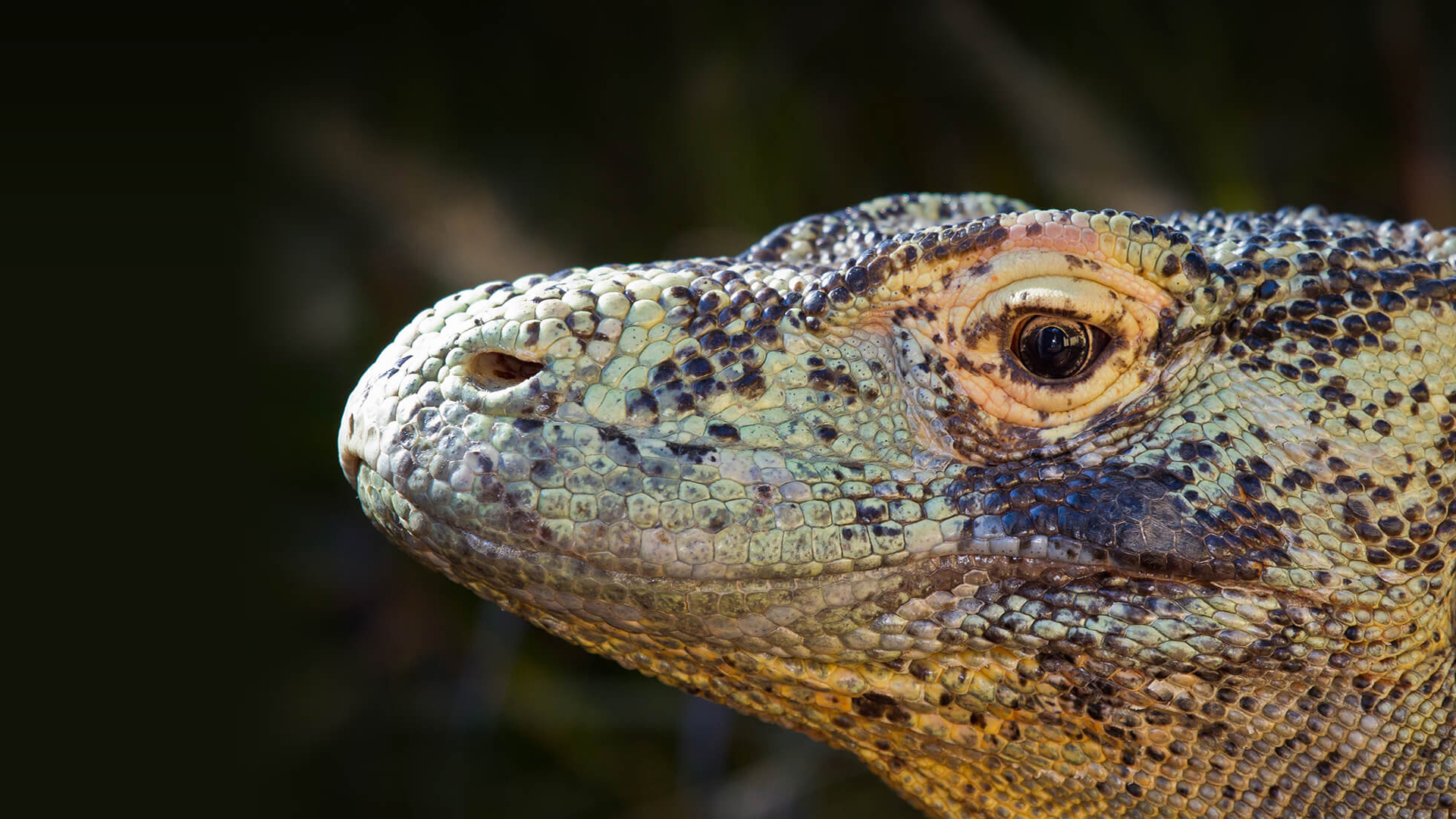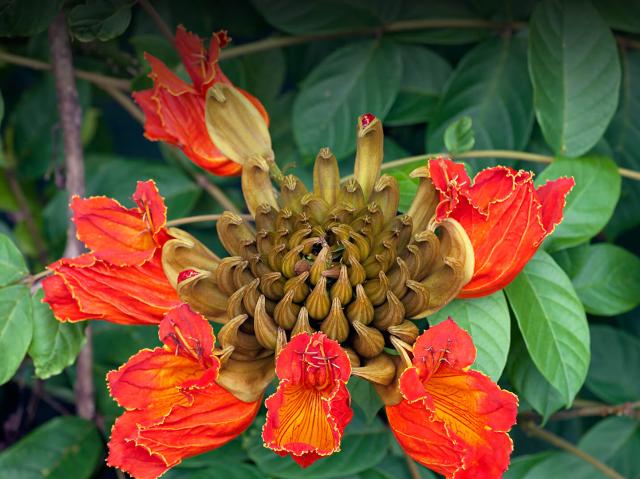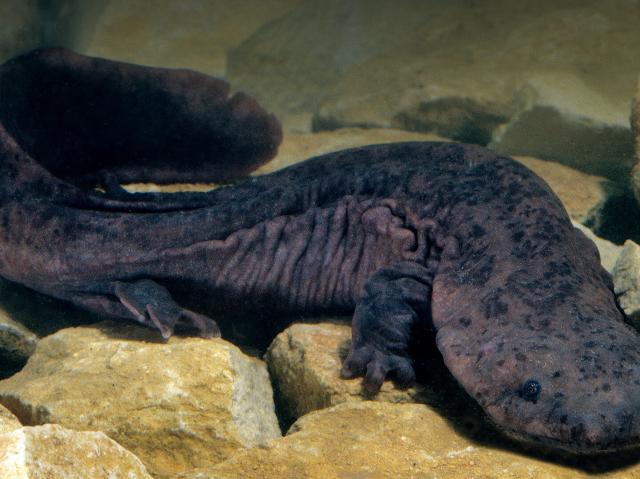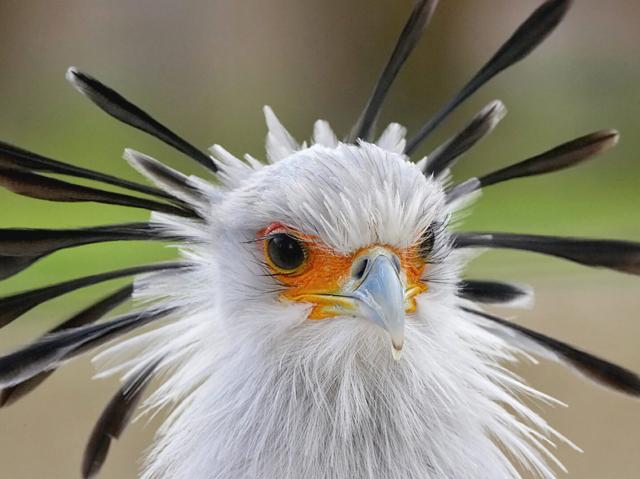
Komodo Dragon

- CLASS: Reptilia (Reptiles)
- ORDER: Squamata
- FAMILY: Varanidae
- GENUS: Varanus
- SPECIES: komodoensis

ABOUT
King of the lizards: There are over 3,000 lizard species, but the Komodo dragon wins the prize for being the largest living lizard in the world! It is a type of monitor lizard, an ancient group of reptiles with ancestors that date back more than 100 million years. Komodo dragons were unknown by western scientists until 1912, and their common name came from rumors of a large dragon-like lizard occurring in the Lesser Sunda Islands. Indeed the yellow color of the Komodo dragon’s long, forked tongue reminds people of mythical dragons that spit fire!
These large lizards range in color from black to yellow-gray, depending on their location, and have a rough, durable skin reinforced with osteoderms (bony plates) protecting them from injuries from scratches and bites. Komodo dragons also have a large, muscular tail and long, powerful claws.
HABITAT AND DIET
Komodo dragons live on only five islands in southeastern Indonesia: Indonesia’s four islands within Komodo National Park (Komodo, Rinca, Gili Montang, Gili Dasami), and the island of Flores. The islands are volcanic in origin, rugged and hilly, and covered with both forest and savanna grassland. Komodo dragons have the smallest home range of any large predator in the world! They like it hot, with daytime temperatures during the dry season that often reach 95 degrees Fahrenheit (35 degrees Celsius) with 70-percent humidity.
Some dragons scratch shallow burrows to rest in at night to keep warm, and as a cool shelter to retreat to from the heat of the day. They may either make their own burrows or use an existing one another lizard created. Sometimes these burrows can be seen along the slopes of dry streambeds among tree roots. However, not all Komodo dragons use burrows; in fact, one adult male on Komodo Island often sleeps at night in an abandoned hut that visitors used to stay in!
An adult dragon leads a life of leisure. It emerges from its burrow to look for a sunny spot to warm up in. Then it’s off to find breakfast, followed by a nice long nap in the shade during the hottest part of the day. After a late afternoon meal, the dragon is ready for bed, sleeping soundly in its burrow until a new day begins. It is a solitary creature that lives and hunts alone.
An adult Komodo dragon eats whatever food is available. Its natural prey, however, is the Timor deer. The deer are wary and quite agile, requiring the dragon to resort to lying in ambush in the long grass next to game trails, in order to be successful in hunting. When the deer passes by, the dragon uses its long claws and sharp teeth to attack. If the prey escapes, the dragon can rely on its long tongue to find its whereabouts, even up to a mile away (1.6 kilometers) away!
Komodo dragons also eat water buffalo and wild pigs, both of which were introduced by people, as well as snakes and fish that wash up on the shore. On Rinca and Komodo islands, pigs have become common in some areas and are now competitors for food with the big lizards. Some dragons have visible scars from conflicts with wild boars. Komodo dragons may also be cannibalistic. Fortunately, the young spend their lives in trees, which likely helps reduce their risk of predation from the adults.
In addition, Komodo dragon saliva contains potentially harmful bacteria that are thought to help weaken prey that are too large for a single dragon to overpower. Some recent research suggests that Komodo dragons might also be venomous due to some of the properties of components in their saliva. Whether they are venomous or not is subject to interpretation at this time; it is too early to make this conclusion until more research is done.
On the smaller islands of Gili Motang and Gili Dasami, within Komodo National Park, the Komodo dragons were discovered to be notably smaller than those found on the nearby islands of Rinca and Flores. Genetically, these dragons were found to be related to those on neighboring islands, so what could account for the discrepancy is size? Gili Motang, for example, is not as high in elevation as Rinca and Komodo, lacks a cloud forest at its peak, and has a much drier climate than does neighboring Rinca and Flores. In fact, fresh water has not been observed on Gili Motang.
Furthermore, the density and number of Timor deer was found to be much lower as well on both of these islands. It is believed that the dragons on these islands are merely adapting to a reduced food supply by decreasing body size in response to a decreased availability of food. The Komodo dragons on these islands are quite wary, and it is thought that cannibalism is a greater threat to young dragons here than on the larger islands.
FAMILY LIFE
Like many reptiles, the number of Komodo dragon females that nest every year often changes, due to the availability of prey and the physical condition of the female. Female dragons do not breed every year. During these “rest” years, females recover from the energy costs incurred by their bodies from egg production during fertile years.
Female dragons use three different nest types for their eggs: hillside nests, ground nests, and mound nests built by the orange-footed scrub fowl. Females often dig decoy nest chambers to discourage predators, including male Komodos and other female dragons, from disturbing existing nests sites when digging their own nests.
The orange-footed scrub fowl builds nests made of leaves and debris, forming a natural incubator from the heat produced from the decomposing leaves. It is easy to distinguish the source of nest-building activities, as the scrub fowl nests from January to April while the female Komodo dragons’ nest digging occurs in August and September. One study indicated that female Komodo dragons showed a marked preference for selecting mound nests over hillside and ground nests.
Komodo dragons begin their life in an egg the size of a grapefruit. The female lays between 15 and 30 eggs, and guards her nest and eggs for the first few months. Life for a young dragon is not easy. As soon as the baby hatches, it scrambles out of the nest and scurries up the nearest tree so the adults won’t eat it. That’s right—adult dragons regard the hatchlings as easy meals! Fortunately for the babies, the adults are too heavy and clumsy to climb trees.
Youngsters live in the trees eating anything that fits into their mouth: eggs, grasshoppers, beetles, and geckos. However, their primary diet is the Tokay gecko, an aggressive lizard itself with an unmistakably loud call! The young dragons find them most often in the hollows of tree trunks where the geckos nest and shelter. When they are about 4 years old and 4 feet long (1.2 meters), the Komodo dragons are large enough to try life on the ground.
AT THE ZOO
The San Diego Zoo acquired its first two Komodo dragons in 1968. They were believed to be a "pair" (male and female), but were too young when they arrived for us to be absolutely certain about that. It wasn’t until 1975, when they were sexually mature that hormonal analyses revealed that they were both females, and so we began to search for a breeding-loan male. Named One Eye, that male arrived from the Basel Zoo in Switzerland in 1976, but no offspring were ever produced.
In 1994, the San Diego Zoo received six young Komodo dragons on loan from the Cincinnati Zoo. We planned to find an easy, safe way to determine the sex of Komodos at a young age. After nine months of blood sampling and ultrasound exams, we found that we could determine the sex of two-year-old dragons successfully. This knowledge is tremendously helpful for managed-care breeding programs. The technique also proved successful in determining the sex of all our monitor lizards as well as Gila monsters and beaded lizards.
The Kenneth C. Griffin Komodo Kingdom at the Zoo opened in 2021.
CONSERVATION
The magnificent Komodo dragon is endangered. Some might think that the largest lizard in the world wouldn’t have to worry about its safety. One study estimated the population of Komodo dragons within Komodo National Park to be 2,405. Another study estimated between 3,000 and 3,100 individuals. On the much larger island of Flores, which is outside the National Park, the number of dragons has been estimated from 300 to 500. Komodo dragons that live outside of the National Park are at greatest risk, as habitat fragmentation and frequent burning of grasslands to hunt Timor deer are the greatest risks to their survival. On the island of Flores, Komodo habitat is shrinking quickly because of the impact of a human population of approximately 2 million.
San Diego Zoo Wildlife Alliance participates in conservation research to help these carnivorous giants. We are learning about the population biology of Komodo dragons in Komodo National Park. By studying Komodo dragon births, deaths, survival, and growth, we hope to learn many important things that will enable us to better conserve and manage them. In addition, we are exploring how things such as prey availability and rainfall influence the biology of the different dragon populations across Komodo National Park.
Before we started this project, many basic pieces of information that are needed to manage and conserve Komodo dragons were unknown, including how many Komodo dragons live on each island, how different the populations are among the islands, and if the dragons move much among islands. Over the years we have been able to provide answers to some of these questions. For example, we now know that despite living across several islands, dragons only occasionally swim to other islands and thus seem to be homebodies.
Furthermore, Komodo dragons tend to remain within the same valleys they were hatched in. Similarly, females often nest in the same nest location each time. We have some initial information that suggests that to become a very big male it may take as much as 20 years of growth, while for females 5 to 7 years seems to be when they are reach maturity. We still have much to learn about these incredible reptiles!
By supporting San Diego Zoo Wildlife Alliance, you are our ally in saving and protecting wildlife worldwide.
LIFE SPAN
About 30 years
YOUNG
Number of eggs laid: 15 to 30
Incubation period: 3 to 8 months, for most
Length at hatch: 12 inches (30 centimeters)
Age of maturity: 5 to 7 years
SIZE
Length: females up to 6 feet (1.8 meters); males up to 10 feet (3 meters)
Weight: females up to 154 pounds (70 kilograms); males up to 300 pounds (136 kilograms)
FUN FACTS
Inside a Komodo dragon’s mouth are about 60 short, sharp teeth designed to cut and tear flesh. They look like shark teeth and have been compared to those of an extinct saber-toothed cat.
A Komodo dragon goes through four or five sets of teeth in a lifetime.
In Komodo National Park, there are four times as many male Komodo dragons as there are females.
Komodo dragons eat extremely quickly. They have been seen consuming 5.5 pounds of meat in one minute.










